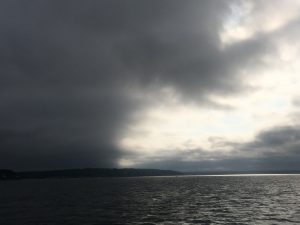 There’s nothing worse than the sinking feeling in your stomach when you look at a weather forecast and read ” wind 30 knots, gusting to 45, seas 7-9 feet.” Our boat is heavy, we know when to shorten sail (have the minimum amount of canvas up to sail safely), and we can take it. But how nice not to be out in it if you really don’t have to.
There’s nothing worse than the sinking feeling in your stomach when you look at a weather forecast and read ” wind 30 knots, gusting to 45, seas 7-9 feet.” Our boat is heavy, we know when to shorten sail (have the minimum amount of canvas up to sail safely), and we can take it. But how nice not to be out in it if you really don’t have to.
Late summer and early fall in New England always bring remnants of hurricanes and nor’easters. No matter what plans you might have or who you might be meeting in any specific port, you’re better off not testing the weather and taking unnecessary risks. As we sail we constantly look at anchorages and keep them in mind if they would make good hurricane holes. (A hurricane hole is a harbor that is landlocked enough to block high winds and small enough to prevent fetch (seas) from building.)
When we were in Newport we started reading reports that Hurricane Jose, though not making landfall in the US, would come close enough to shore to bring high winds and high seas. Luckily, the three days before the storm was projected to hit, we were going to have wind in our favor or no wind (easy enough to motor). So we made a plan to get as far down into Long Island Sound as we could where we could find protection.
Saturday morning we topped off gas, diesel and water tanks in Newport and then headed to Fishers Island. We had to motor pretty much the whole way and it was foggy, but we’ve been to Fishers Island before and it’s an easy, wide open anchorage, so there was little risk in doing it in the fog.
Sunday morning (again, very foggy), we headed further southwest to New Haven. We anchored in Morris Cove, which is south of the city by several miles, but an easy in and out, and good protection with multiple breakwaters in place.
Monday we made our final push down to Northport with a fantastic wing-on-wing (main on one side, jib on the other) sail. We had several options, but picked Northport because: a) The mud is incredibly thick which means it holds the anchor well, b) North of the mooring field is a wide open bay where we could safely anchor away from other boat traffic and reduce the risk of being hit if someone dragged, and c) The bay is a decent hurricane hole. It doesn’t have high enough land to protect from much of the wind, but it is almost entirely landlocked, so very little fetch can build.
We stripped the windage (anything that might blow away), put extra lines around the sails and sailcovers, tied off the wind generator, and hunkered down for three days. And we got lucky. The original forecast called for winds gusting to 50 and seas 8-10 feet. The storm instead moved further east and we saw winds of only 30-35 knots and almost no fetch. I got a lot of reading done, Trip did a bunch of projects, we watched several movies, and then we moved on.

Recent Comments